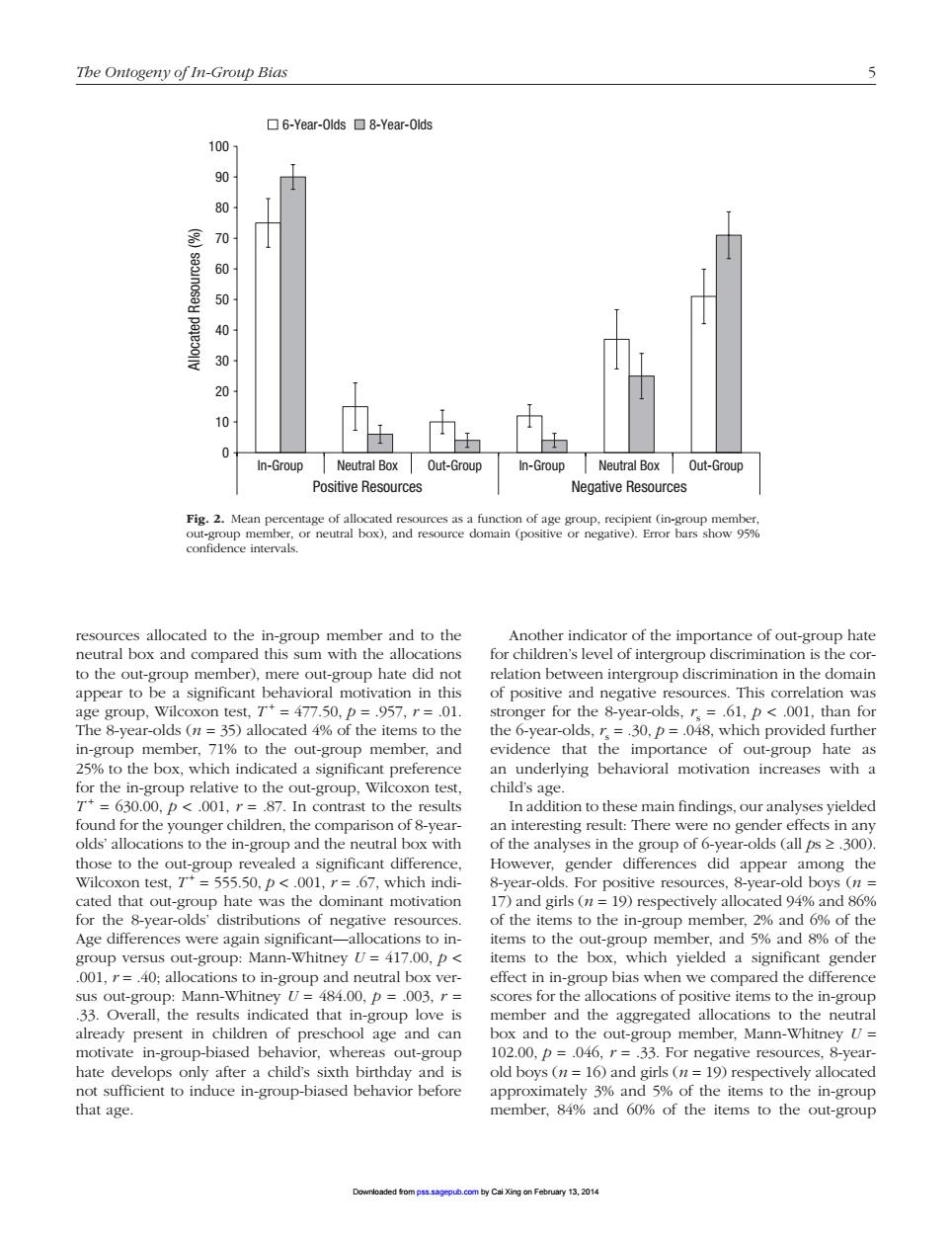正在加载图片...

The Ontogeny of In-Group Bias 口6-Year-0lds口8-Year-0lds 100 90 60 0 20 10 0 In-Group Neutral Box Out-Group In-Group Neutral Box Out-Group Positive Resources Negative Resources fun )and re urce domain (po aiocdptetngoRmmandaae resources allocated to the in Another indicator of the importance of out-group hate for children's level of intergroup discrimination is the cor to the out-group member).mere out-group hate did not relation between intergroup discrimination in the domain appear to be of positive and negative resources.This correlation was age group.test. ted 402 onger fo o in-group member,71%to the out-group member.and evidence that the importance of out roun hate as 25%to the box,which indicated a significant preference an underlying behavioral motivation increases with a for the in-group relative to the out-group,Wilcoxon test, 30.00,p<.001, childs age n a ion to these main findings,our analyses yielde olds'allocations to the in-gre oup and the neutral box with of p f(all 0) those to the out-group revealed a significant difference However.gender differences did appear among the Wilcoxon test,T =555.50,p<.001,r=.67,which indi 8-year-olds.For positive resources,8-year-old boys (n t outgroup hate was the 1 19)respectively alloc ed 9 Age diffe to in. items to the out-g nd 5%6 and 8o of the oup versus out-group:Mann-Whitney U=41700 5 items to the box,which yielded a significant gende 001.r= .40;allocations to in-group and neutral box ver effect in in-group bias when we compared the difference oupMann-wh 0,p .005, ocations of pos ve items to th ent in children and can box and to the Mann-Whimey motivate in-group-biased behavior.whereas out-group 102.00.p=.046,r=.33.For negative resources,8-year hate develops only after a child's sixth birthday and is old boys (n=16)and girls (n 19)respectively allocated the items to the in-group 50% the o the ou-gou 1.201 The Ontogeny of In-Group Bias 5 resources allocated to the in-group member and to the neutral box and compared this sum with the allocations to the out-group member), mere out-group hate did not appear to be a significant behavioral motivation in this age group, Wilcoxon test, T + = 477.50, p = .957, r = .01. The 8-year-olds (n = 35) allocated 4% of the items to the in-group member, 71% to the out-group member, and 25% to the box, which indicated a significant preference for the in-group relative to the out-group, Wilcoxon test, T + = 630.00, p < .001, r = .87. In contrast to the results found for the younger children, the comparison of 8-yearolds’ allocations to the in-group and the neutral box with those to the out-group revealed a significant difference, Wilcoxon test, T + = 555.50, p < .001, r = .67, which indicated that out-group hate was the dominant motivation for the 8-year-olds’ distributions of negative resources. Age differences were again significant—allocations to ingroup versus out-group: Mann-Whitney U = 417.00, p < .001, r = .40; allocations to in-group and neutral box versus out-group: Mann-Whitney U = 484.00, p = .003, r = .33. Overall, the results indicated that in-group love is already present in children of preschool age and can motivate in-group-biased behavior, whereas out-group hate develops only after a child’s sixth birthday and is not sufficient to induce in-group-biased behavior before that age. Another indicator of the importance of out-group hate for children’s level of intergroup discrimination is the correlation between intergroup discrimination in the domain of positive and negative resources. This correlation was stronger for the 8-year-olds, rs = .61, p < .001, than for the 6-year-olds, rs = .30, p = .048, which provided further evidence that the importance of out-group hate as an underlying behavioral motivation increases with a child’s age. In addition to these main findings, our analyses yielded an interesting result: There were no gender effects in any of the analyses in the group of 6-year-olds (all ps ≥ .300). However, gender differences did appear among the 8-year-olds. For positive resources, 8-year-old boys (n = 17) and girls (n = 19) respectively allocated 94% and 86% of the items to the in-group member, 2% and 6% of the items to the out-group member, and 5% and 8% of the items to the box, which yielded a significant gender effect in in-group bias when we compared the difference scores for the allocations of positive items to the in-group member and the aggregated allocations to the neutral box and to the out-group member, Mann-Whitney U = 102.00, p = .046, r = .33. For negative resources, 8-yearold boys (n = 16) and girls (n = 19) respectively allocated approximately 3% and 5% of the items to the in-group member, 84% and 60% of the items to the out-group 0 10 20 30 40 50 60 70 80 90 100 In-Group Neutral Box Out-Group In-Group Neutral Box Out-Group Positive Resources Negative Resources Allocated Resources (%) 6-Year-Olds 8-Year-Olds Fig. 2. Mean percentage of allocated resources as a function of age group, recipient (in-group member, out-group member, or neutral box), and resource domain (positive or negative). Error bars show 95% confidence intervals. Downloaded from pss.sagepub.com by Cai Xing on February 13, 2014